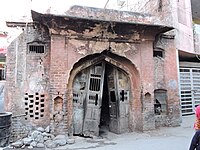
Mani Majra

Sector 13, Chandigarh | |
|---|---|
| Coordinates: 30°43′09″N 76°50′01″E / 30.71917°N 76.83361°E | |
| Country | |
| Union Territory | Chandigarh |
| Population | |
• Total | Around 2 Lakh |
| Time zone | UTC+5:30 (Indian Standard Time) |
| PIN | 160101 |
| Vehicle registration | CH |
Sector 13 is a commercial and residential hub in Chandigarh. Manimajra and adjoining urban areas developed by Chandigarh administration were reconstituted as Sector 13.[1][2]

Old Manimajra is a historical Puadhi Dialect town which was established by the Gharib Dass Dhillon as the capital of the newly created princely state, Manimajra State.[3]

The residents of posh localities like Modern Housing Complex (MHC), NAC, Shivalik Enclave and Uppal Marble Arc had for long been demanding to be included in the sectoral grid of the city and not naming them with old Manimajra, which finally happened by Feb 2020.[4]

The notifications regarding the renaming were issued by the Punjab Governor and Chief Administrator of Chandigarh, VP Singh Badnore under the Punjab Reorganization Order 1966 under the Sub-section (2) of Sector-1 of the Capital of Punjab (Development and Regulations) Act 1952.[5]

Some residential societies and urban housing complexes to mention are Mari Wala Town (M.W.T.), Pipliwala Town (P.W.T.), Shanti Nagar, Subhash Nagar, Shastri Nagar, Adarsh Nagar, Kishangarh, Bhagwanpura, New Indira Colony, Old Indira Colony, Dharshani Bhag, Samadhi Gate, Mohalla Jattan Wala, Mohalla Main Bazar, Govindpura, Mori gate, Nagla Mohalla, Railway Colony, Mouli Jagra, Mouli Pind, Vikas Nagar, Daria , Shivalik Enclave, Modern Housing Complex (M.H.C.), Duplex, Rajeev Vihar and Uppal's Marble Arch.

Railway Station, Asia's no. 1 Motor Market, NAC commercial market and Kalagram are established here.

Two multiplexes, Fun Republic and DT mall are also situated nearby for shopping and Cinema.

Sports complex, GOVT Dispensary, Shivalik Park, RIMT World School, DC Montessori school, Gurukul Global School, Lohia International School, and 4 GOVT schools are also available.

The Rajiv Gandhi IT Park of Chandigarh is also planned here. Various corporations — such as, Airtel, Infosys, Tech Mahindra — have built their campuses.

A 5-star hotel 'The Lalit' is also here at IT Park Industrial Area with a petrol pump before the hotel.

The sector also is home to an old fort that is undergoing restoration as a part of an Archeological Survey of India's restoration project. Parts of the Hollywood film Zero Dark Thirty were shot here.[6]

History

The town of Mani Majra was founded in 1515 by Mani Ram Dhillon who was a Zamindar and Chaudhary of the area under the Lodhi Dynasty of Delhi Sultanate. His descendant remained the Zamindars of the area. In 18th century Chaudhary Gangaram Singh Dhillon held Mani Majra and 84 other villages as a vassal zamindar of the Mughal Empire. His son was Chaudhary Garibdas Singh. After the death of Zin Khan, the Governor of Sirhind, and the break up of the Imperial power, he took possession of 84 villages, which his father held as an officer for the Empire, and further extended his territory by seizing the fort of Pinjore. Here the Raja of Nahan attacked him, but without success; and placing his father in charge, Gharibdas Singh left intent on fresh conquest. It was during his absence that the Raja of Nahan having obtained aid from Patiala, attacked the fort as described in the text, and captured it, Gangaram Singh being slain. Gharibdas Singh hastened back, but was not strong enough to attempt to recapture the fort. He, however, expelled the Nahan Raja from Chandangarh, which he had captured shortly before.


Mani Majra was a princely state during the Sikh period and there is a fort built by Gareeb Dass Dhillon, Jatt by caste, and Mullanpur Gareebdass a village near Chandigarh border is also named after him.[7] The fort was built by Gharib Dass Dhillon (also spelled Gareeb Das) of Dhillon clan as the capital of his newly created state of 84 villages. Garib Das submitted to Patiala State. Dhillons of Manimajra later also occupied Sailba, 28 km northwest of Manimajra and now in SAS Nagar district, and Gurbakhsh Singh Dhillon was appointed kiladar (governor) of the Sailba fort.[3] Gharib Das died in 1783, leaving two sons, Gopal Singh and Parkash Chand. The elder of these did excellent service in 1809, and again in the Gurkha campaign of 1814. Sir D. Ochterlony was about to recommend him for a new jagir, but he requested instead the title of Raja, which was given to him. Mansa Devi, which is situated on the Shivalik foothills in village Bilaspur, Tehsil and District Panchkula,was built during the period 1811-1815 by Raja Gopal Singh. He died in 1816, and was succeeded by Raja Hamir Singh, who only survived his father a few years. Raja Goverdhan Singh, his son, was loyal in 1845(Anglo Sikh War) to the Britishers,and gave a detachment which was engaged at Mudki and elsewhere. He died in 1847, and was succeeded by Raja Gurbaksh Singh, who died in 1866, when his younger brother Raja Bhagwan Singh, inherited the state. Raja Bhagwan Singh died without any heir and his state was annexed by British government. The Fort of Mani Majra was later given to Raja of Faridkot as Rani Suraj Kaur Sahiba, daughter of Bhagwan Singh, married Raja Balbir Singh of Faridkot. After Independence, the town of Manimajra was long headed by Sardar Ajit Singh Dhillion. Ajit Singh with his decisive leadership helped Muslim families of Manimajra to stay in the town unharmed at time of partition of India and Pakistan(1947).Now being a Sector in Chandigarh (Sector-13) this comes under Municipal Corporation Chandigarh. The Ranas Of Kuthar a princely state of the British Raj, located in modern-day Himachal Pradesh migrated to Manimajra and owned large stake of land in areas near the township.

Manimajra Shiv Temple and Thakurdwara is 500 to 600 years old, and was built by the rulers of the area. Shiv temple has Shiva as the main deity and Thakurdwara has Rama, Sita, and Hanuman as chief deities.[7]

Gallery
-
Mani Majra Fort, south side entrance view
-
Mani Majra Fort, east side view
-
Mani Majra Fort, west side view
-
Mani Majra Fort, north side view
-
Mani Majra Fort, ruined courtyard view
References
- ^ "It's official: Chandigarh's Manimajra is now Sector 13". Hindustan Times. 11 February 2020. Retrieved 14 June 2020.
- ^ Service, Tribune News. "UT Administrator issues notification on renaming city areas". Tribuneindia News Service. Retrieved 14 June 2020.
- ^ a b Bhagat Singh,1993, A History of the Sikh Misals.
- ^ "Manimajra to be renamed Sector 13, residents elated". The Times of India. 6 January 2020. ISSN 0971-8257. Retrieved 6 March 2024.
- ^ India news, ZeeNews (12 February 2020). "Chandigarh readies for 'Sector 13', eight areas notified under this new sector". Zeenews India. Zee News India. Retrieved 14 June 2020.
- ^ "Manimajra residents hope 'Zero Dark Thirty will win Oscar". The Times of India. 12 February 2013. Archived from the original on 18 May 2013. Retrieved 24 February 2013.
- ^ a b Haryana Samvad Archived 29 November 2018 at the Wayback Machine, Oct 2018.
External links
See what we do next...
OR
By submitting your email or phone number, you're giving mschf permission to send you email and/or recurring marketing texts. Data rates may apply. Text stop to cancel, help for help.
Success: You're subscribed now !






